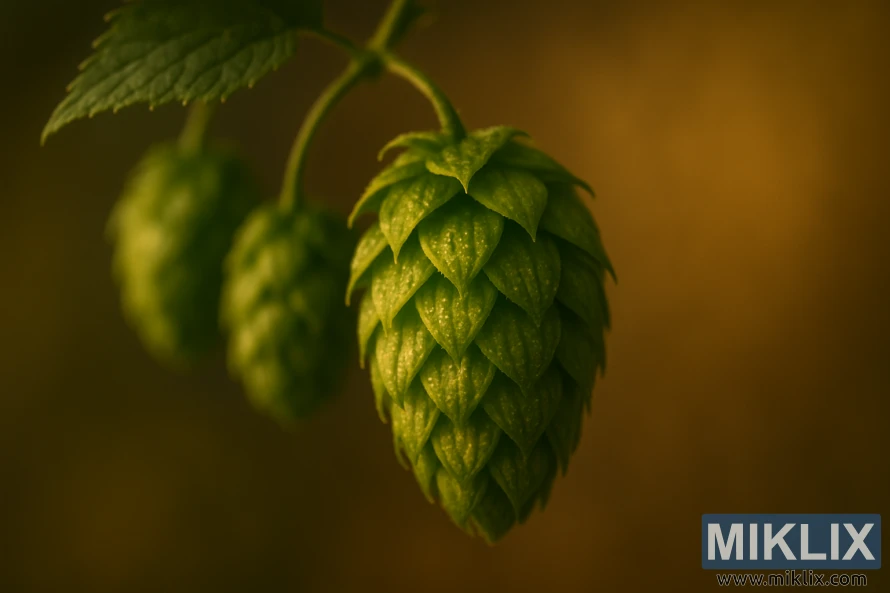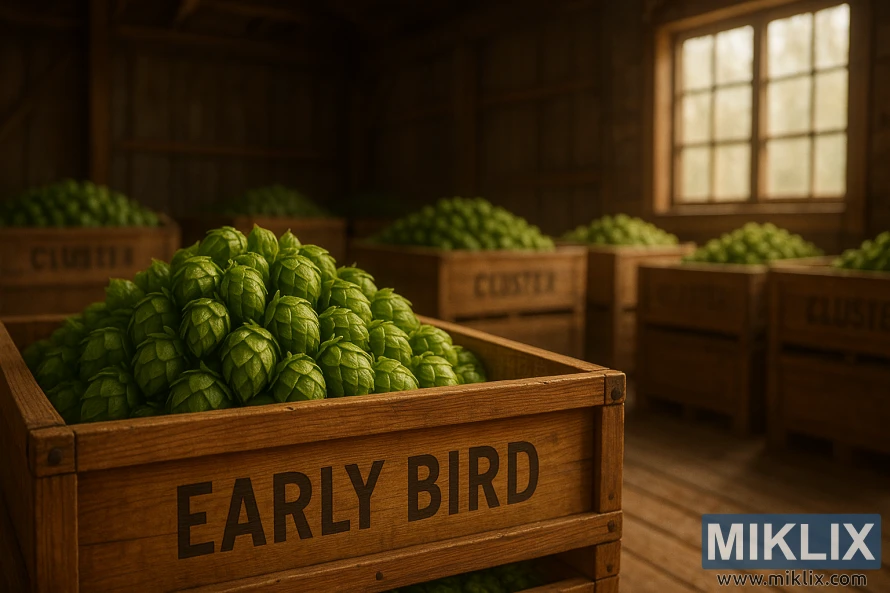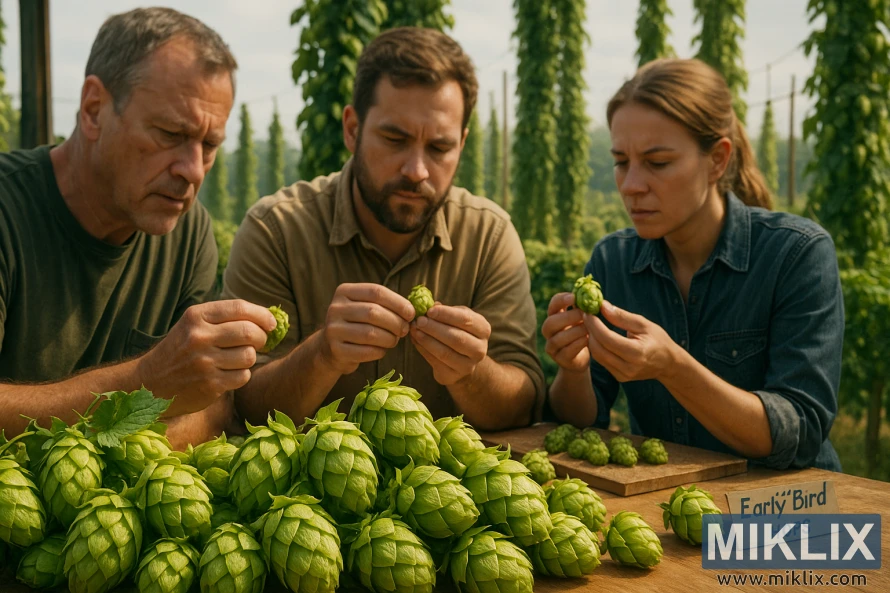Hops in Beer Brewing: Early Bird
Published: September 8, 2025 at 8:53:10 AM UTC
Craft beer enthusiasts are always searching for new ways to craft unique flavors. The use of Early Bird Hops in beer brewing is becoming increasingly popular. These hops bring a distinct aroma and flavor, taking the brewing process to new levels. As the demand for craft beer grows, brewers are looking for innovative techniques and ingredients. Early Bird Hops offer a unique characteristic that can enhance the brewing experience. This guide will explore the history, characteristics, and brewing techniques of Early Bird Hops.

Key Takeaways
- Understanding the role of Early Bird Hops in beer brewing
- Exploring the unique characteristics of Early Bird Hops
- Learning brewing techniques that utilize Early Bird Hops
- Discovering the history and significance of Early Bird Hops
- Applying knowledge to create unique beer flavor profiles
Introduction to Early Bird Hops
The tale of Early Bird Hops starts in Kent, England's historic hop-growing areas. They were a subvariety of East Kent Goldings. This variety has a long history, valued for its unique traits and versatility in brewing.
Being a subvariety of East Kent Goldings, Early Bird Hops inherited a distinctive aroma and flavor. These traits have made them a favorite among brewers. Their development was influenced by traditional hop-growing practices in the region.
Early Bird Hops' unique qualities make them a key ingredient in many beer styles. Knowing their history and origin offers insights into their use in modern brewing.
Today, Early Bird Hops are celebrated for their role in beer's flavor and aroma. They reflect Kent's hop-growing heritage and tradition.
The Distinctive Profile of Early Bird Hops
Early Bird Hops introduce a unique citrus and spice flavor to brewing. This makes them essential for brewers seeking complex, balanced flavors in their beers.
Their flavor profile is rich in citrus, with orange and lemon notes, and subtle spice undertones. This versatility allows them to enhance a broad spectrum of beer styles.
The aroma of Early Bird Hops is equally distinctive. It offers a fragrant blend that enriches the beer's sensory experience. Key aroma characteristics include:
- Citrus notes, providing a bright and uplifting quality
- Subtle spice undertones, adding depth and complexity
- A hint of floral notes, rounding out the aroma profile
By using Early Bird Hops, brewers can achieve a nuanced balance of flavors and aromas. This elevates the quality of their beers. Whether in IPAs, pale ales, or other styles, Early Bird Hops create a rich, engaging drinking experience.

Understanding Early Bird Hop Chemistry
For brewers aiming to unlock the full flavor of Early Bird Hops, grasping their chemical composition is essential. The unique blend of alpha and beta acids in these hops is key. These components significantly influence the beer's bitterness, flavor, and aroma.
Alpha acids are the backbone of hop bitterness in beer. Early Bird Hops boast a specific alpha acid percentage, influenced by factors like growing conditions and harvesting methods. This percentage is critical in shaping the beer's bitterness profile.
Beta acids, though less impactful on bitterness, are vital for flavor and aroma. They undergo oxidation, forming compounds that deeply affect the beer's character. The balance between alpha and beta acids in Early Bird Hops makes them adaptable for a wide range of beer styles.
- The alpha acid content in Early Bird Hops typically ranges between 10% to 14%.
- Beta acids are present in smaller quantities, usually around 4% to 6%.
- The ratio of alpha to beta acids influences the overall hop character and its suitability for different brewing applications.
Early Bird Hops' distinct chemical makeup makes them ideal for various brewing needs. From bittering to adding flavor and aroma, their versatility is unmatched. By delving into their chemistry, brewers can craft recipes that fully showcase these hops' capabilities.
Best Beer Styles for Early Bird Hops
Early Bird Hops stand out for their unique flavor and aroma. They are perfect for several popular beer styles. Their distinct profile can elevate hop-forward brews.
They are ideal for IPA, pale ale, and other hoppy ales. Their versatility lets brewers try new recipes and techniques. This results in complex, balanced flavors.
- IPA (India Pale Ale): Known for its hoppy flavor and aroma, IPA is a perfect match for Early Bird Hops.
- Pale Ale: A balanced beer style that showcases the hop characteristics without overpowering the malt.
- Double IPA: For those who prefer a stronger hop flavor, Double IPA is an ideal style.
- Session IPA: A lower ABV version of IPA, great for hop enthusiasts who want to enjoy the flavor without the high alcohol content.
These beer styles benefit from Early Bird Hops' unique characteristics. Their flavor and aroma compounds add to a balanced, complex beer profile.
Brewing Techniques with Early Bird Hops
Brewing with Early Bird Hops requires a detailed approach to unveil their unique traits. Brewers can use several techniques, such as dry hopping and strategic hop additions, to enhance their flavor. These methods are key to unlocking the full spectrum of Early Bird Hops' characteristics.
Dry hopping stands out as a top method for highlighting Early Bird Hops' aromatic qualities. By adding hops after fermentation, brewers protect the delicate flavors and aromas. This technique ensures that the distinct profile of Early Bird Hops is prominently featured in the beer.
Timing is also critical in brewing with Early Bird Hops. Late additions, for instance, boost the beer's aroma and flavor without adding too much bitterness. By mastering these techniques, brewers can craft beers that are both complex and balanced, highlighting Early Bird Hops' strengths.
Exploring different brewing methods and hop schedules is essential for brewers. Whether through dry hopping, late additions, or a mix of techniques, the aim is to bring out the best in Early Bird Hops. This approach leads to the creation of exceptional beers.
Early Bird Hops Storage and Handling
To preserve the distinct characteristics of Early Bird Hops, brewers must adhere to best practices in storage and handling. Proper storage conditions are essential to maintaining the quality and flavor profile of these hops.
Temperature control is a critical factor in hop storage. It is recommended to store Early Bird Hops in a cool, refrigerated environment, typically between 32°F and 40°F (0°C and 4°C), to slow down the degradation process. This temperature range helps in preserving the hops' alpha acids, essential oils, and overall flavor and aroma characteristics.
Humidity is another important consideration. Hops should be stored in a dry environment to prevent moisture from affecting their quality. The ideal relative humidity for storing hops is typically considered to be around 50%. This helps in preventing the growth of mold and the loss of hop cones' integrity.
Packaging also plays a significant role in maintaining the quality of Early Bird Hops. Hops are often packaged in airtight containers or vacuum-sealed bags to minimize exposure to oxygen, which can lead to oxidation and a loss of flavor and aroma. Brewers should handle these packaged hops carefully to prevent damage.
Here are some key practices for handling Early Bird Hops:
- Minimize exposure to light, as it can cause hops to degrade.
- Handle hops gently to prevent mechanical damage.
- Keep hops away from strong-smelling substances, as they can absorb odors easily.
- Use clean equipment when handling hops to prevent contamination.
By adhering to these storage and handling best practices, brewers can ensure that their Early Bird Hops retain their unique characteristics and contribute to the production of high-quality beers.

Comparing Early Bird Hops to Similar Varieties
To truly appreciate Early Bird Hops, it's essential to compare them with other well-known hop varieties. East Kent Goldings, a traditional English hop, is one of Early Bird Hops' closest relatives. It's celebrated for its balanced flavor and aroma.
Early Bird Hops and East Kent Goldings share earthy and floral notes. Yet, Early Bird Hops stand out with a sweeter and fruitier profile.
Brewers should consider several factors when comparing these hops. These include alpha-acid content, oil composition, and flavor profile. Here's a brief comparison:
- Alpha-acid content: Early Bird Hops have a moderate alpha-acid content, similar to East Kent Goldings.
- Flavor profile: Early Bird Hops boast a complex flavor profile. It includes fruit, spice, and earthy undertones.
- Aroma: The aroma of Early Bird Hops is floral and slightly sweet. This makes them a great addition to various beer styles.
Understanding the comparison between Early Bird Hops and other varieties helps brewers make informed decisions. This enhances the quality and character of their beers.
Common Challenges When Brewing with Early Bird Hops
Brewing with Early Bird Hops offers a rewarding experience, yet it presents its own set of challenges. Achieving the right balance of flavors and aromas is a primary issue. Early Bird Hops have a distinctive profile, which can lead to over-hopping or under-hopping if not managed properly.
Over-hopping results from adding too many hops, causing the beer to taste bitter or have an overwhelming hop flavor. Under-hopping, on the other hand, occurs when too few hops are used, resulting in a beer lacking the desired hop character. Both scenarios can greatly affect the beer's overall quality.
To sidestep these common pitfalls, brewers should follow key guidelines. Understanding the alpha-acid content of Early Bird Hops and adjusting hopping rates is essential. Also, the timing of hop additions significantly impacts the final flavor and aroma of the beer.
Here are some tips for brewing with Early Bird Hops:
- Monitor hop addition rates to avoid over-hopping.
- Adjust brewing recipes based on the alpha-acid content of the hops.
- Experiment with different hop varieties to find the optimal blend.
- Pay close attention to the timing of hop additions during the brewing process.
By being aware of these challenges and taking steps to mitigate them, brewers can unlock the full flavor of Early Bird Hops. This allows them to create unique, high-quality beers that showcase the hops' distinctive characteristics.

Recipe Development Guidelines
Creating a beer recipe with Early Bird Hops demands a careful balance of flavors. Brewers must think about the interaction between grain bills, hop additions, and yeast selection. This ensures a well-rounded beer.
The distinct taste of Early Bird Hops can be accentuated by the right grain bill. For example, a pale malt base can enhance the hops' flavor and aroma.
Hop additions are key in recipe development. Brewers can try various hop addition times to find the perfect balance of bitterness, flavor, and aroma.
- Select a grain bill that complements the flavor profile of Early Bird Hops.
- Experiment with different hop addition times to achieve the desired balance.
- Choose a yeast strain that enhances the overall character of the beer.
By considering these factors and experimenting with different combinations, brewers can craft complex and balanced beers. These showcase the unique qualities of Early Bird Hops.
Quality Control and Assessment
To produce high-quality beer with Early Bird Hops, brewers must prioritize quality assessment. This involves evaluating the beer's flavor and aroma to identify any issues that may impact the final product.
Quality control is critical in the brewing process, ensuring the beer meets desired standards. When brewing with Early Bird Hops, assessing the beer's characteristics is essential. This includes its bitterness, flavor, and aroma.
- Evaluate the beer's bitterness level to ensure it aligns with the desired style.
- Assess the flavor profile to identify any off-flavors or inconsistencies.
- Check the aroma to ensure it meets the expected characteristics.
To maintain high-quality standards, brewers should implement a rigorous quality control process. This includes:
- Regularly sampling the beer during the brewing process.
- Conducting sensory evaluations to assess the beer's flavor and aroma.
- Using analytical tools to measure the beer's chemical composition.
By prioritizing quality control and assessment, brewers can ensure their beer meets the desired standards. This is vital when brewing with Early Bird Hops. Their unique characteristics can be affected by various factors, such as storage and handling conditions.
In conclusion, quality control and assessment are key steps in brewing with Early Bird Hops. By implementing a rigorous quality control process, brewers can produce high-quality beer that meets the desired standards.

Commercial Brewing Applications
Early Bird Hops stand out for commercial brewers seeking innovation. Their unique flavor and aroma can set beers apart in a competitive market.
In large-scale brewing, these hops are perfect for a range of beer styles, from pale ales to IPAs. Their distinct characteristics are ideal for brewers aiming to craft complex, full-bodied beers.
- Unique flavor and aroma profiles
- Versatility in various beer styles
- Potential for differentiation in a competitive market
For successful commercial brewing with Early Bird Hops, brewers must focus on hop storage, handling, and brewing techniques. This approach unlocks the full benefits of this innovative hop variety.
The brewing industry's evolution will likely see more use of Early Bird Hops in commercial brewing. This opens up new avenues for brewers to create unique and high-quality beers.
Seasonal Considerations and Availability
Seasonal factors are key in determining Early Bird Hops availability, impacting brewing schedules. Brewers must plan meticulously to maintain a steady supply of premium hops.
Hop harvesting is seasonal, requiring brewers to forecast their needs months in advance. Early Bird Hops, like others, are harvested annually. This necessitates precise planning to prevent shortages or excesses.
To effectively manage hop availability, brewers should adhere to these strategies:
- Align hop purchases with brewing schedules and demand forecasts.
- Secure contracts with hop suppliers for a consistent Early Bird Hops supply.
- Regularly check hop inventory levels to prevent shortages during busy periods.
Brewing schedules may need adjustments based on Early Bird Hops availability. Being flexible in operations allows breweries to use the freshest hops, ensuring top-quality beers.
Understanding and adapting to seasonal factors affecting Early Bird Hops helps brewers maintain a reliable supply chain. This ensures consistent production of high-quality beers that satisfy consumer demands.
Maximizing Hop Efficiency in Your Brew
Brewers can greatly improve their beer's quality by optimizing Early Bird Hops usage. Achieving the perfect flavor and aroma is key. To do this, brewers must grasp the techniques and strategies for using Early Bird Hops effectively.
Timing is everything when it comes to hop additions. Early Bird Hops, with their unique flavor and aroma, can be added at different stages. Early additions contribute to bitterness, while later ones enhance flavor and aroma.
Adjusting the hopping rate based on wort specific gravity is also important. Higher gravity worts need more hops for the right bitterness and flavor. It's vital to balance hop additions with wort gravity for maximum efficiency.
Brewing techniques significantly impact hop efficiency. Techniques like hop stands or dry-hopping can greatly improve flavor and aroma. These methods allow hops to infuse into the beer without the harshness of boiling.
- Optimize hop additions based on the brewing process stage.
- Adjust hopping rates according to wort specific gravity.
- Utilize brewing techniques like hop stands or dry-hopping.
By using these strategies, brewers can unlock the full flavor of Early Bird Hops. It's also important to monitor and adjust these techniques based on the specific brew and desired outcome.
In conclusion, maximizing hop efficiency with Early Bird Hops requires strategic hop additions and optimized brewing techniques. Understanding and applying these principles can elevate beer quality. Brewers can fully utilize Early Bird Hops' unique characteristics.
Conclusion
Early Bird Hops have become a key ingredient in beer brewing, adding a unique flavor and aroma. They can take beer to new heights. By mastering the brewing techniques and understanding the characteristics of Early Bird Hops, brewers can craft beers with complex and balanced flavors.
There's a wealth of knowledge on Early Bird Hops, covering their history and use in different beer styles. Whether you brew at home or commercially, adding Early Bird Hops to your recipe can introduce exciting new flavors. As the brewing world evolves, Early Bird Hops will likely remain a favorite among brewers aiming to innovate and stand out.
In summary, Early Bird Hops open up a world of possibilities for brewers. They can enhance traditional beers or create entirely new flavor profiles. By harnessing the unique qualities of Early Bird Hops, brewers can craft high-quality beers that cater to the changing tastes of beer lovers.
Further Reading
If you enjoyed this post, you may also like these suggestions:
